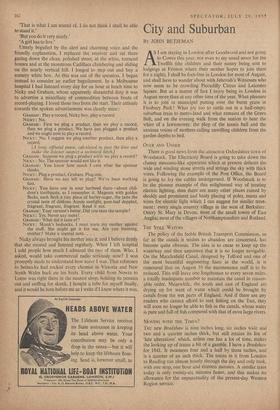City and Suburban
BY JOHN BETJEMAN AsI am staying in London after Goodwood and not going to Cowes this year, nor even to my usual moor for. the Twelfth (the children and their nanny being sent to lodgings at Frinton where their mother hopes to join them for a night), I shall be foot-free in London for most of August, and shall have to wander about with Jehovah's Witnesses who now seem to be crowding Piccadilly Circus and Leicester Square. But as a matter of fact I enjoy being in London in August more,than at any other time of the year. What pleasure it is to join in municipal putting over the burnt grass 'in Finsbury Park! What joy too to rattle out in a half-empty suburban train to metro-land and what remains of the Green Belt, and on the evening walk from the station to hear the whirr of a lawnmower, the plop of the tennis ball and the anxious voices of mothers calling unwilling children from the garden depths to bed.
OVER AND UNDER
There is good news from the attractive Oxfordshire town of Woodstock. The Electricity Board is going to take down the clumsy meccano-like apparatus which at present defaces the wide and winding stone streets and strings the sky with thick wires. Following the example of the Post Office, the Board is going to lay the cables underground. If Woodstock is to be the pioneer example of this enlightened way of treating electric lighting, then there are many other places ruined by shoddy and prominent and hasty placing of poles, masts and wires for electric light which I can suggest for similar treat- ment: every single country village in the west of Berkshire; Ottery St. Mary in Devon; most of the small towns of East Anglia; most of the villages of Northamptonshire and Rutland.
THE STILL WATERS
The policy of the feeble British Transport Commission, so far as the canals it wishes to abandon are concerned, has become quite obvious. The idea is to cease to keep up the waterway and then announce that it is no longer navigable. On the Macclesfield Canal, designed by Telford and one of the most beautiful engineering feats in the world, it is rumoured that on August 10 the maintenance staff is to he reduced. This will leave one lengthsman to every seven miles, a totally inadequate number to maintain the canal in reason- , able order. Meanwhile, the south and east of England are drying up for want of water which could be brought by canals from the wet parts of England. And if there are any readers who cannot afford to rent fishing on the Test, they will soon no longer be able to fish in the canals, whose water is pure and full of fish compared with that of most large rivers.
MOVING WITH TILE TIMIS?
THE new Bradshaw is nine inches long, six inches wide and two and a quarter inches thick, but still retains its list of 'late alterations' which, unless one has a lot of time, makes the looking up of trains a bit of a gamble. I have a Bradshaw for 1841. It measures four and a half by three inches, and is a quarter of an inch thick. The trains in it from London to. Reading ran almost hourly through the day and only took. with one stop, one hour and thirteen minutes. A similar train today is only twenty-six minutes faster, and this makes no allowance for the unpunctuality of the present-day Western Region service.


































 Previous page
Previous page